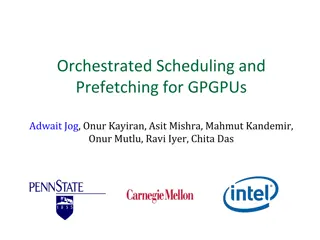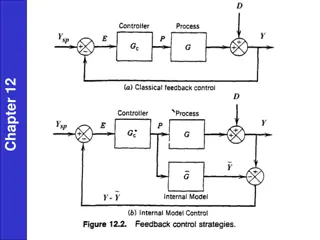Address-first Value-next Predictor with Value Prefetching
Improving single-thread performance in modern processors efficiently is crucial. AVPP proposes optimizations to reduce hardware cost for load value prediction, introducing a new taxonomy of Value Prediction Policies. AVPP outperforms state-of-the-art predictors, providing system performance improvement and energy savings.
Download Presentation

Please find below an Image/Link to download the presentation.
The content on the website is provided AS IS for your information and personal use only. It may not be sold, licensed, or shared on other websites without obtaining consent from the author.If you encounter any issues during the download, it is possible that the publisher has removed the file from their server.
You are allowed to download the files provided on this website for personal or commercial use, subject to the condition that they are used lawfully. All files are the property of their respective owners.
The content on the website is provided AS IS for your information and personal use only. It may not be sold, licensed, or shared on other websites without obtaining consent from the author.
E N D
Presentation Transcript
AVPP: AVPP: Address-first Value-next Predictor with Value Prefetching for Improving the Efficiency of Load Value Prediction Lois Orosa, Rodolfo Azevedo and Onur Mutlu
Executive Summary Motivation: single-thread performance is critical for many applications Problem: improving single-thread performance in modern processors requires techniques that significantly increase the hardware cost Goal: revisit Load Value Prediction as an efficient way to improve single-thread performance Contributions: We propose optimizations for reducing the hardware cost of load value prediction We propose a new taxonomy of Value Prediction Policies AVPP: New load value predictor that predicts the address first and the value next. Increases the coverage of the predictor by prefetching the value of a future instance of the load instruction Results: AVPP outperforms all state-of-the-art value predictors in the context of load value prediction, and it is less complex than predicting all instructions AVPP provides 11.2% system performance improvement and 3.7% energy savings compared to no value prediction. 2
Motivation and Goal Motivation and Goal Background Reducing Hardware Complexity Taxonomy of Value Prediction Mechanism: AVPP Evaluation and Results Conclusion AVPP Outline 3
Motivation and Goal Motivation and Goal Background Reducing Hardware Complexity Taxonomy of Value Prediction Mechanism: AVPP Evaluation and Results Conclusion AVPP Outline 4
Motivation and Goal True data dependencies limit single-thread performance significantly We simulate an oracle predictor that predicts the output of instructions correctly: 28% 32% We observe that an oracle predictor achieves almost the same performance predicting load instructions as predicting all instructions Predicting all instructions requires large predictors Our goal is revisit Load Value Prediction as a low-cost alternative to improve single-thread performance 5
Motivation and Goal Motivation and Goal Background Reducing Hardware Complexity Taxonomy of Value Prediction Mechanism: AVPP Evaluation and Results Conclusion AVPP Outline 6
Background: Value Prediction True Data Dependency: instr_0: A = B + 1 instr_1: C = A + 3 Read-After-Write (RAW) Depends on the result of the previous instruction Value Prediction breaks true data dependencies by predicting values and performing speculative execution Prediction: the output value of instr_0 (A) Speculation: executes instr_1 using the predicted value of A instr_0 and instr_1 are executed in parallel Requires a Rollback mechanism to recover from mispredictions 7
State-of-the-art Value Predictors Last Value Predictor (LVP) [Lipasti+ MICRO 96] The predicted value is the last value Stride Predictor (Stride) [Mendelson+ TR 96] The predicted value is the last value + stride 2D-Stride [Eickemeyer+ IBM Journal 93]: variant that improves performance in loops Finite Context Method (FCM) predictor [Sazeides+ TR 97] Context based predictor Large prediction tables D-FCM [Goeman+ HPCA 01]: variant that uses strides VTAGE [Perais+ HPCA 14] Uses global branch history D-VTAGE [Perais+ HPCA 15]: variant that uses strides 8
Motivation and Goal Motivation and Goal Background Reducing Hardware Complexity Taxonomy of Value Prediction Mechanism: AVPP Evaluation and Results Conclusion AVPP Outline 9
Reducing Hardware Complexity Predicting only load instructions instead of predicting all instructions has some advantages: Decrease the hardware cost: we show that load value predictors have a smaller area footprint Less pressure over shared resources (e.g., Physical Register File): we show how to reduce the number of ports in the paper We leverage the Load Queue for implementing load value prediction Load Instructions are 25% of all instructions on average Small modifications to support Load Value Prediction 10
Previous Works on Reducing Complexity of Value Prediction Value prediction for all instructions: Work [Perais+ HPCA 14] EOLE [Perais+ ISCA 14] BeBOP[Perais+ HPCA 15] [Perais+ MICRO 16] Predictor Entries 8192 8192 2048 2048 Speedup ~10% ~10% 11.2% 5% - Introduces Confidence Counters - Simple mechanism to recover from value mispredictions - Reduces the extra ports required on the PRF - Increases the complexity of the in-order front-end and back-end Single predictor entry for a cache line - Register reuse - Low hardware cost Main contribution for reducing complexity AVPP 512 11.2% Load Value Prediction: Minimal hardware Modifications to an OoO processor 11
Motivation and Goal Motivation and Goal Background Reducing Hardware Complexity Taxonomy of Value Prediction Mechanism: AVPP Evaluation and Results Conclusion AVPP Outline 12
Taxonomy of Value Prediction Policies We propose a new taxonomy for analyzing value prediction design choices 1. Predictor update 2. Prediction availability 3. In-flight pending updates 13
Taxonomy: Predictor Update Policies Where is the predictor updated in the pipeline? 1. Correct update: The predictor is updated at the commit stage 2. Speculative update: The predictor is updated at the fetch stage 14
Taxonomy: Prediction Availability Policies What happens when the prediction is not ready at dispatch time? 1. Delay dispatch The pipeline is stalled waiting for the prediction 2. Not-delay dispatch The prediction is discarded 15
Taxonomy: In-flight Pending Update Policies What happens with back-to-back predictions? 1. In-flight ignore The predictor ignores previous in-flight instructions 2. In-flight wait The predictor waits for previous in-flight instructions to update the predictor 16
Taxonomy We evaluate different combinations of these policies for all predictors we evaluate 17
Motivation and Goal Motivation and Goal Background Reducing Hardware Complexity Taxonomy of Value Prediction Mechanism: AVPP Evaluation and Results Conclusion AVPP Outline 18
AVPP: Address-first Value-next Value Predictor with Data Prefetching Observations: Predicting load instructions has almost the same potential performance benefits as predicting all instructions Addresses are usually more predictable than values Key Ideas: Predict only load instructions to reduce hardware cost Leverage the better predictability of addresses on load instructions to improve performance 19
AVPP: Predictor Overview Two main hardware structures: 1. Address Table (AT): 1. Implemented with any predictor 2. Indexed by the load instruction address 3. Calculates the predicted address 2. Value Table (VT): 1. Indexed by the predicted address 2. Returns the predicted value 2 1 3 Predicted value Predicted address LD instruction address VT VT entry AT AT entry AT predictor entry Confidence pdis d tag value 3bits 3bits 1bit 20
AVPP: Prediction Overview (II) AVPP predicts the output of every load instruction The prediction happens in the front-end of the pipeline Confidence mechanism to improve accuracy [Perais+ HPCA 14] If the prediction is confident, write the result in the target register Speculatively execute all the dependent instructions 1 2 3 Predicted address LD Instruction address Predicted value VT AT 1 2 3 Load Front-end Exec. (OoO) Commit 3 1 4 2 3 TIME 4 Dependent instruction Front-end Exec. (OoO) Commit 21
AVPP: Update Overview Update the AT at commit of every load instruction Update the VT: At the commit of every store instruction. Keeps the VT coherent with memory At the commit of every load instruction? at the commit of every load instruction ? 7 Should we update the VT 9 Load Front-end Exec. (OoO) Load Address Commit Value LD instruction address Store Address 5 7 6 TIME AT VT 9 7 Store Front-end Exec. (OoO) Store Address Commit Store Value Load Address 8 9 TIME 22
AVPP: Updating the VT at Each Load Instruction Correct predictions : 0 PC Instruction Predictor stage: predicting Predictor stage: updating tag Last value 8 12 16 Stride Predictor Stride Last addr addr value 40: LD [4] 40: LD [8] 40: LD [12] 40: LD [16] - 4 40 4 4 8 12 16 10 3 9 13 8+4=12 12+4=16 AT VT MISS HIT HIT HIT MISS MISS tag val VT always misses No valid predictions 4 8 12 16 10 3 9 13 L1 Cache 23
AVPP: Prefetching Overview Idea: Prefetch values from the memory hierarchy into VT to increase the VT hit ratio The prefetch address is calculated at each address prediction Generated when the prediction is confident Predicted to be accessed by future instances of the same load instruction Dynamic prefetch distance (details in the paper) The VT is updated with the prefetched values 3 4 Prefetch address 1 2 Predicted address LD Instruction address coverage, not to hide memory latency The goal of prefetching is to increase the predictor VT 4 AT Prefetch Value Prefetch address 3 24
AVPP: Updating the VT with Prefetching PC Instruction Predictor stage: predicting Predictor stage: updating tag Last value 8 12 16 Stride Predictor HIT HIT HIT Stride Last addr addr value 40: LD [4] 40: LD [8] 40: LD [12] 40: LD [16] - 4 40 4 8+4=12 12+4=16 Correct predictions : 0 12 16 20 9 1 2 13 2 AT VT HIT HIT MISS Valid Predictions VT hits because we prefetch the right values into it tag val 4 8 12 16 20 10 3 9 13 2 L1 Cache 25
AVPP: Putting All Together Leverages the better predictability of addresses on load instructions to improve performance Two basic hardware structures: AT: predicts the address first VT: predicts the value next Prefetches future instances of the load instruction to improve the VT hit rate 26
Motivation and Goal Motivation and Goal Background Reducing Hardware Complexity Taxonomy of Value Prediction Mechanism: AVPP Evaluation and Results Conclusion AVPP Outline 27
Experimental Setup Simulation platform: ZSIM [Sanchez+ ISCA 13] : 4-issue OoO cores, TAGE branch predictor, 128-entry ROB, 32KB L1 caches, 256KB L2s, Stream prefetchers McPAT [Li+ MICRO 09] for estimating the energy consumption Predictors evaluated: LVP, 2D-Stride, DFCM, VTAGE, DVTAGE, AVPP-DVTAGE, AVPP-Stride 512 entries 23 selected benchmarks from SPEC2000 SPEC2006 PARSEC/SPLASH2 28
Evaluation: Speedup 5.9% 11.2% AVPP outperforms the state-of-the-art predictors 11.2% speedup over no value prediction 29
Evaluation: Energy 2.6% 3.7% AVPP outperforms the state-of-the-art predictors 3.7% energy savings over no value prediction 30
Coverage of the Load Value Predictors 36% 44% Coverage of a predictor: percentage of loads for which a prediction is used for speculation AVPP covers more load instructions than the state-of-the-art AVPP covers 44% of the load instructions 31
Evaluation: Accuracy Accuracy is higher than 99.8% in all predictors because of the use of the confidence counters 32
Where are the Benefits Coming from? 4.8% 1.8% 10.6% AVPP prefetching alone does not provide significant performance improvement AVPP prediction alone provides only 4.8% speedup The full AVPP achieves 10.6% speedup 33
More Results in the Paper Multi-core simulations Cache hit distribution Distribution of the prefetch request that hits in L1, L2 and main memory Sensitivity studies on Memory hierarchy (larger caches) Load Queue size Impact of different load value prediction implementation policies 34
Motivation and Goal Motivation and Goal Background Reducing Hardware Complexity Taxonomy of Value Prediction Mechanism: AVPP Evaluation and Results Conclusion AVPP Outline 35
Executive Summary Motivation: single-thread performance is critical for many applications Problem: improving single-thread performance in modern processors requires techniques that significantly increase the hardware cost Goal: revisit Load Value Prediction as an efficient way to improve single-thread performance Contributions: We propose optimizations for reducing the hardware cost of load value prediction We propose a new taxonomy of Value Prediction Policies AVPP: New load value predictor that predicts the address first and the value next. Increases the coverage of the predictor by prefetching the value of a future instance of the load instruction Results: AVPP outperforms all state-of-the-art value predictors in the context of load value prediction, and it is less complex than predicting all instructions AVPP provides 11.2% system performance improvement and 3.7% energy savings compared to no value prediction. 36
AVPP: AVPP: Address-first Value-next Predictor with Value Prefetching for Improving the Efficiency of Load Value Prediction Lois Orosa, Rodolfo Azevedo and Onur Mutlu
BACKUP 38
Cache Hit Distribution of the predicted load instructions Most of the predicted load instructions hit into L1 cache 39
Cache Hit Distribution of AVPP-DVTAGE prefetch requests Most of the AVPP prefetch requests hit into L1 cache 40
Coverage of AVPP-DVTAGE with and without prefetching The coverage of the predictor largely improves with prefetching 41
VT hit rate with and without prefetching Prefetching increases the VT hit rate 42
Impact of the Prediction Policies The best policy depends on the microarchitecture 43
Impact of the Predictor Size 512 entries is a sweet spot 44
Impact of the VT Table Size 64 VT entries is a sweet spot 45
Impact of Cache Configurations The speedup of load value prediction does not depend much on the cache configuration 46
Store Set Prediction and L2 Prefetching The L2 Prefetcher and Load Value Prediction (LVP) are complementary 47
L1 prefetching VS AVPP When AVPP and L1 prefetcher are used together the performance is additive in many benchmarks 48
Multithreaded and Multiprogram Mixes AVPP outperforms previous predictors 49























